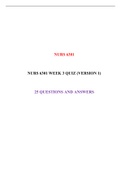Samenvatting
Samenvatting Architecture and Modelling of Management Information Systems - cursus
- Instelling
- Katholieke Universiteit Leuven (KU Leuven)
This document is a summary of the cursus 'enterprise information systems engineering: the merode approach' written by professor Monique Snoeck. It is an extensive summary, but does not contain any examples. Best understandable when combined with the classes.
[Meer zien]













